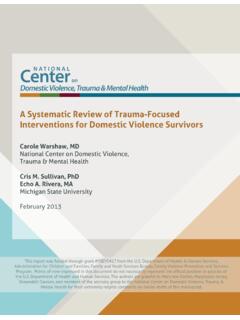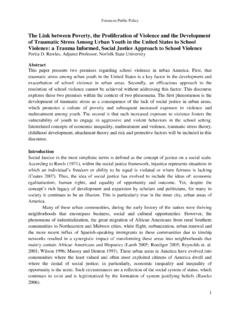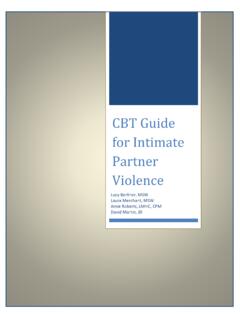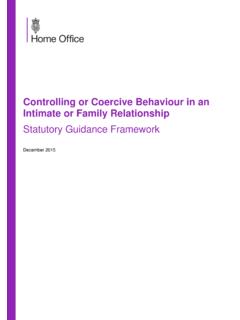Transcription of National Intimate Partner and Sexual Violence Survey
1 National Intimate Partner and Sexual Violence Survey : 2015 Data Brief Updated ReleaseThe National Intimate Partner and Sexual Violence Survey :2015 Data Brief Updated ReleaseSharon G. Smith, Xinjian Zhang, Kathleen C. Basile, Melissa T. Merrick, Jing Wang, Marcie-jo Kresnow, Jieru ChenCenters for Disease Control and PreventionRobert R. Redfield, MD, DirectorNational Center for Injury Prevention and ControlDebra E. Houry, MD, MPH, DirectorDivision of Violence PreventionJames A. Mercy, PhD, DirectorNovember 2018 National Center for Injury Prevention and ControlCenters for Disease Control and PreventionAtlanta, GeorgiaSuggested Citation:Smith, , Zhang, X., Basile, , Merrick, , Wang, J., Kresnow, M., Chen, J. (2018). The National Intimate Partner and Sexual Violence Survey (NISVS): 2015 Data Brief Updated Release.
2 Atlanta, GA: National Center for Injury Prevention and Control, Centers for Disease Control and National Intimate Partner and Sexual Violence Survey :2015 Data Brief Updated ReleaseSexual Violence , stalking, and Intimate Partner Violence are serious public health problems affecting millions of people in the United States each year. These forms of Violence are associated with chronic physical and psychological adverse health conditions, and Violence experienced as a child or adolescent is a risk factor for repeated victimization as an adult. First launched in 2010 by CDC s National Center for Injury Prevention and Control, the National Intimate Partner and Sexual Violence Survey (NISVS) is an ongoing, nationally representative Survey that assesses Sexual Violence , stalking, and Intimate Partner Violence victimization among adult women and men in the United brief report presents the highlights from the 2015 data year of NISVS.
3 Data tables are presented at the end of the report. Recognition is given to the team of people that substantially contributed to the original development of the National Intimate Partner and Sexual Violence Survey : Kathleen C. Basile, Michele C. Black, Matthew J. Breiding, James A. Mercy, Linda E. Saltzman, and Sharon G. Smith (contributors listed in alphabetical order). Sexual ViolenceHow NISVS Measured Sexual ViolenceFour types of Sexual Violence are included in this brief report. These include rape, being made to penetrate someone else, Sexual coercion, and unwanted Sexual contact. Rape is any completed or attempted unwanted vaginal (for women), oral, or anal penetration through the use of physical force (such as being pinned or held down, or by the use of Violence ) or threats to physically harm and includes times when the victim was drunk, high, drugged, or passed out and unable to consent.
4 Rape is separated into three types: completed forced penetration, attempted forced penetration, and completed alcohol- or drug-facilitated penetration. Among women, rape includes vaginal, oral, or anal penetration by a male using his penis. It also includes vaginal or anal penetration by a male or female using their fingers or an object. Among men, rape includes oral or anal penetration by a male using his penis. It also includes anal penetration by a male or female using their fingers or an object. Being made to penetrate someone else includes times when the victim was made to, or there was an attempt to make them, sexually penetrate someone without the victim s consent because the victim was physically forced (such as being pinned or held down, or by the use of Violence ) or threatened with physical harm, or when the victim was drunk, high, drugged, or passed out and unable to consent.
5 Among women, this behavior reflects a female being made to orally penetrate another female s vagina or anus or another male s anus. Among men, being made to penetrate someone else could have occurred in multiple ways: being made to vaginally penetrate a female using one s own penis; orally penetrating a female s vagina or anus; anally penetrating a male or female; or being made to receive oral sex from a male or female. It also includes male and female perpetrators attempting to force male victims to penetrate them, though it did not coercion is unwanted Sexual penetration that occurs after a person is pressured in a nonphysical way. In NISVS, Sexual coercion refers to unwanted vaginal, oral, or anal sex after being pressured in ways that included being worn down by someone who repeatedly asked for sex or showed they were unhappy; feeling pressured by being lied to, being told promises that were untrue, having someone threaten to end a relationship or spread rumors.
6 And Sexual pressure due to someone using their influence or Sexual contact is unwanted Sexual experiences involving touch but not Sexual penetration, such as being kissed in a Sexual way, or having Sexual body parts fondled, groped, or Sexual Violence is a combined measure that includes rape, being made to penetrate someone else, Sexual coercion, and/or unwanted Sexual in 14 menwas made to penetrate someone (completed or attempted) during his in 5 womenexperienced completed or attempted rape during her lifetime. The National Intimate Partner and Sexual Violence Survey | 2015 Data Brief 1 Sexual Violence of Women In the , of women (nearly million) experienced some form of contact Sexual Violence in their lifetime (Figure 1), with of women experiencing this Violence in the 12 months preceding the Survey (Table 1).
7 Approximately 1 in 5 ( or an estimated million) women in the reported completed or attempted rape at some point in their lifetime. o About of women experienced completed forced penetration, experienced attempted forced penetration, and experienced completed alcohol/drug-facilitated penetration at some point in their lifetime. In the , of women (approximately million) reported completed or attempted rape in the 12 months preceding the Survey . Approximately of women (nearly million) have been made to penetrate someone else in their lifetime. Approximately 1 in 6 women ( or an estimated million women) experienced Sexual coercion ( , being worn down by someone who repeatedly asked for sex, Sexual pressure due to someone using their influence or authority) at some point in their lifetime.
8 More than a third of women ( or approximately million women) reported unwanted Sexual contact ( , groping) in their 1 Lifetime Prevalence of Sexual Violence Victimization Women, NISVS 2015 050%Contact Sexual (completed or attempted)Made to penetrateSexual coercionUnwanted Sexual contact All percentages are weighted to the Contact Sexual Violence includes rape, being made to penetrate someone else, Sexual coercion, and/or unwanted Sexual 2 The National Intimate Partner and Sexual Violence Survey | 2015 Data BriefSexual Violence of Men Nearly a quarter of men ( or million) in the experienced some form of contact Sexual Violence in their lifetime (Figure 2), with of men experiencing contact Sexual Violence in the 12 months preceding the Survey (Table 2).
9 About 1 in 14 men ( or nearly million) in the was made to penetrate someone else (attempted or completed) at some point in their lifetime. o Approximately of men were made to penetrate through completed forced penetration, experienced situations where attempts were made to make them penetrate someone else through use of force, and were made to penetrate someone else through completed alcohol/drug facilitation at some point in their lifetime. In the , of men (an estimated 827,000 men) reported being made to penetrate (attempted or completed) in the 12 months preceding the Survey . About of men (an estimated million) experienced completed or attempted rape victimization in their lifetime. Approximately 1 in 10 men ( or an estimated million men) experienced Sexual coercion ( , being worn down by someone who repeatedly asked for sex, Sexual pressure due to someone using their influence or authority) in their lifetime.
10 Almost one fifth of men ( or approximately million men) reported unwanted Sexual contact ( , groping) at some point in their 2 Lifetime Prevalence of Sexual Violence Victimization Men, NISVS 2015 050%Contact Sexual violenceRape (completed or attempted)Made to penetrateSexual coercionUnwanted Sexual contact All percentages are weighted to the Contact Sexual Violence includes rape, being made to penetrate someone else, Sexual coercion, and/or unwanted Sexual The National Intimate Partner and Sexual Violence Survey | 2015 Data Brief 3 Age at First Completed or Attempted Rape and Made to Penetrate Females A majority of female victims of completed or attempted rape first experienced such victimization early in life, with (nearly million victims) reporting that it first occurred prior to age 25 (Table 3).
















